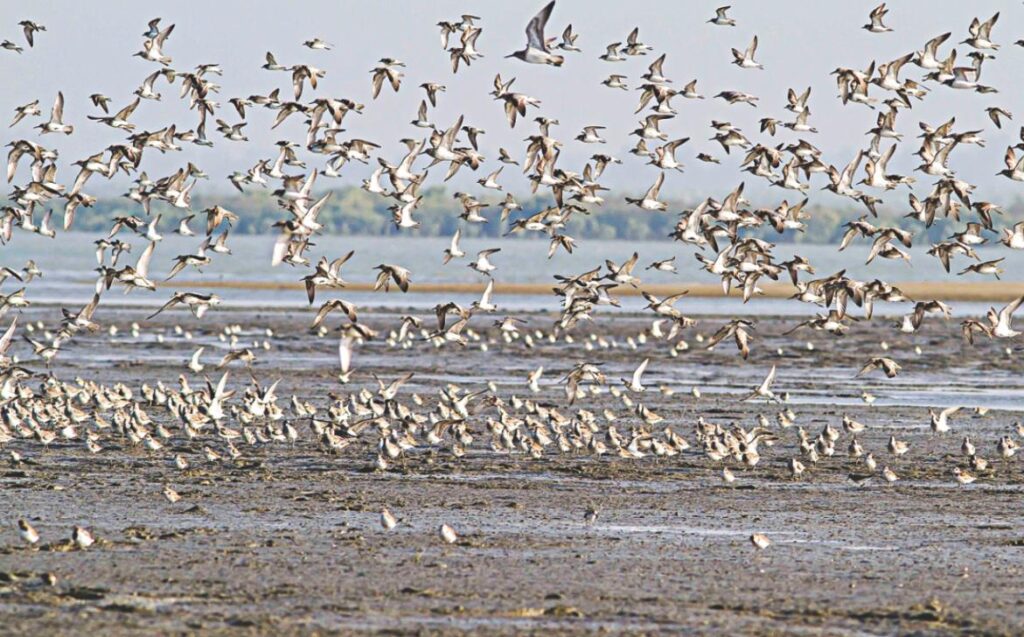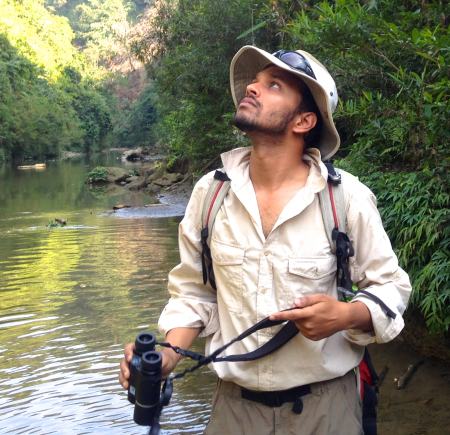
I remember my failed attempts to draw the convoluted coast of Bangladesh during art classes possibly 25 years ago. To me it always looked like the work of a confused painter, or like the crisscross scratches of a tiger’s claws. The twists of the Sundarbans on the east, intersecting thousands of creeks and hundreds of rivers, then to the west of the Sundarbans there are countless islands, constantly disappearing and emerging, swallowing the homes of some and creating new niches for others. Further east of the Ganges-Brahmaputra delta, there is a more stable coast that has remained unchanged for a long time.
I first visited the coastal islands of Bhola District in 2004, since then the coast has enchanted me. The loneliness of boats sailing into the horizon, the space between islands, the desolation of semi-feral buffaloes or the men in charge of them, the call of a solitary goose, or the sight of a fisherman waiting for the right tide. Most travellers see these images when visiting our coast, not just the villages but beyond.
It is interesting what people from different backgrounds see when they look at a landscape, the contrast between seen and unseen beauty and value, the urge for preservation versus the greed for alteration. What most people do not see in these coastal mudflats are the hidden treasures of our biological diversity. Every year more than one hundred thousand birds visit our mudflats to feed on the invisible life that flourishes on mud, silt and clay found in intertidal areas. These areas generally support a range of invertebrates, which are extremely productive biologically. These include benthic organisms, molluscs, crustaceans and marine worms.
Mudflats provide an important nursery and feeding ground for many fish species. Shallow water zones along our south central coast are critical habitats for Hilsa and Pangas. It’s striking that our coastal mudflats still hold seven globally threatened and twelve other near-threatened resident and migratory birds. Irrawaddy Dolphins still come to the water surface to breathe and to offer a smile to the fishermen. Most of these areas are still wild and unchanged, such as Sonadia Island in Cox’s Bazar and the islands around Hatia, Sandwip and Bhola. They are yet to be marred by development.
In our travels along the coast over the last decade, my colleagues and I have come across many puzzles in science, especially in case of the critically endangered Spoon-billed Sandpiper. This is one of the rarest birds on planet, with only 200 breeding pairs left, and it is likely to go extinct if we do not take action. I was fascinated by very basic questions: where have they come from? where are they going? why they are on one mudflat and not another? where do they roost during high tide and forage during low tide? We have now solved many of these questions, and finding these answers give meaning to the lives of biologists. However, the answers that science provides merely underpin conservation policy and practice, they do not constitute the actual protection of species and their habitats. These answers are only relevant if our decision makers listen to the recommendations that we as scientists offer.
Conservation in Bangladesh has mostly focused on the forests and their fascinating diversity, although how much we have managed to protect our forests is debatable. Attention to coastal or intertidal wetlands has been largely limited, or even totally omitted as areas of conservation interest by many of our decision-making bodies. Yet mudflats and tidal areas offer immense and irreplaceable value in biological diversity, number, uniqueness, beauty and their contributions to human livelihoods.
There is beauty anywhere you look across these mudflats, as I have tried to illustrate in the photographs here. Hundreds of tiny organisms live in and on the mud, offering food for birds at low tide, and feeding fish and dolphins at high tide. Finding these new lands where no scientist has ever explored is exciting but depressing at the same time. The terror of losing it engulfs me every time I see something worth preserving. Not because of any conflict with the local community, but due to the ignorance and arrogance of the decision-makers on the value of ecosystem conservation. Glimpses of such undisturbed wilderness are rare treasures for a conservation biologist. At the same time, the sight is filled with the fear that it will not remain untouched for long and we may lose it tomorrow.

I hear people talking about large-scale development or reclamation, or relocating people along the newly emerged land to find more room for people, This misses several critical issues that we should be more concerned about: human population stabilization, holistic policy that will strongly consider environmental concerns and protecting the natural resource including fisheries base found in such places that ultimately we depend on for food. Not to mention that Bangladesh is committed to conserve its coastal wetlands, migratory species and biodiversity in general as we have signed major international agreements and partnerships such as the Conservation of Migratory Species of Wild Animals (CMS), the Ramsar Convention, Convention on International Trade in Endangered Species of Wild Fauna and Flora (CITES), the East Asian-Australasian Flyway Partnership (EAAFP) and the World Heritage Convention (WHC).
The gap in understanding by decision-makers here is in thinking that these areas are barren, unoccupied and lifeless; when they are actually inhabited by all manner of life that we need in order to sustain our own food supply. In a recent interview world-renowned conservationist George Schaller said: “one thing people tend to forget is that everything you have, need, want comes from nature. You can’t say we are going to have GDP of 8% forever – endless growth is impossible. So, your economists are a century behind in their thinking if you don’t protect your nature. Growth doesn’t measure destruction, the pollution, erosion, loss of plants and animals and so forth, so you have a figure but then what? It will ultimately go down.”

Ultimately it is our decisions and actions that will either allow life on mudflats to thrive, to give us life-giving services that we so seldom see or calculate, and to retain the chance to one day listen to the surreal songs of the shores. Or to alter the landscape in the name of development for short-term benefits and change our colorful coast into silent shores forever?
Photo Credit: Sayam U Chowdhury

The writer is a Conservation Biologist and Ornithologist, currently working on threatened species conservation and research in Bangladesh and abroad. He can be reached at [email protected].